Vladimir Putin catalyzed a storm in world grain markets by resuming Russia’s blockade of Ukraine’s corn and wheat exports. Indian Prime Minister Narendra Modi may make it a perfect one with a partial ban on India’s rice sales.
India has quietly undergone a second green revolution over the past decade, with rice yields climbing by 20%, according to the U.S. Department of Agriculture. The downside of this boom is that it has given India, with 1.4 billion of its own mouths to feed, a whopping 40% of world exports for this essential grain.
With domestic food price inflation edging back toward 5% annually, and a general election pending next spring, Modi decided that India needs more rice at home. A moratorium announced on July 20 could cut exports in half.
“Modi’s going into an election year, and food inflation is very central,” comments Kona Haque, head of research at commodities consultant ED&F Man. (Western foodies can take heart; basmati rice is exempted.)
The timing is unfortunate for Bangladesh, Indonesia, and other nations that depend on Indian rice. Rice prices already soared 30% in the past 10 months, thanks largely to flooding in No. 4 exporter Pakistan, says Joseph Glauber, senior research fellow at the International Food Policy Research Institute.
Global rice inventories are at a six-year low, notes Zanna Aleksahhina, an analyst at consultant Mintec Global. Production in Thailand and Vietnam, the No. 2 and No. 3 exporters, is maxed out.
And 2023 is an El Niño year. This cyclical weather event, driven by warmer water in the Pacific Ocean, tends to make Asia hotter and drier—bad for rice, which thrives in wetness. But specifics across the vast continent are hard to predict.
That wild card, plus broader climate-change-related weather weirdness, is pushing Modi to protect domestic food reserves. The Indian leader has played grain politics before, to limited effect. A wheat export ban last year was riddled with loopholes, Glauber says, like exemptions for neighboring countries and “humanitarian” sales.
This time looks different, says Shahnawaj Khan, agricultural research manager at Hyderabad-based Mordor Intelligence. “Considering the current situation, it is highly unlikely for the government to enter any side deals,” he says.
If all goes well, with regular summer monsoon rains and a healthy autumn harvest, Modi will ease export restrictions in late November, Khan predicts.
That could mean a hungry spell ahead for India’s South Asian neighbors and a smattering of rice-intensive African countries.
Bangladesh’s 173 million people depend on rice for two-thirds of their calorie intake, according to IFPRI figures, and Indonesians and Sri Lankans, more than 40%.
Unlike corn, wheat, and soybeans, which are also used to feed animals, rice is a subsistence grain, eaten almost entirely by humans. That leaves less chance for high prices to reduce consumption.
Aggregate global food prices have tapered off from a spike following Russia’s 2022 invasion of Ukraine, but are still at their highest levels since the 1970s in real terms, according to the United Nations Food and Agriculture Organization. Paying for imports in a surging dollar is draining vulnerable treasuries, Haque points out.
Sales from a state reserve in Japan saved the day during the last rice crisis—when India, Thailand, and Vietnam all cut exports to cope with the 2008-09 global financial meltdown, Glauber says.
The market has gotten too big for Tokyo to bail out this time. Pray for a good monsoon.
Email: [email protected]
Read the full article here





